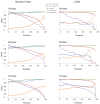Considering patient clinical history impacts performance of machine learning models in predicting course of multiple sclerosis
- PMID: 32196512
- PMCID: PMC7083323
- DOI: 10.1371/journal.pone.0230219
Considering patient clinical history impacts performance of machine learning models in predicting course of multiple sclerosis
Abstract
Multiple Sclerosis (MS) progresses at an unpredictable rate, but predictions on the disease course in each patient would be extremely useful to tailor therapy to the individual needs. We explore different machine learning (ML) approaches to predict whether a patient will shift from the initial Relapsing-Remitting (RR) to the Secondary Progressive (SP) form of the disease, using only "real world" data available in clinical routine. The clinical records of 1624 outpatients (207 in the SP phase) attending the MS service of Sant'Andrea hospital, Rome, Italy, were used. Predictions at 180, 360 or 720 days from the last visit were obtained considering either the data of the last available visit (Visit-Oriented setting), comparing four classical ML methods (Random Forest, Support Vector Machine, K-Nearest Neighbours and AdaBoost) or the whole clinical history of each patient (History-Oriented setting), using a Recurrent Neural Network model, specifically designed for historical data. Missing values were handled by removing either all clinical records presenting at least one missing parameter (Feature-saving approach) or the 3 clinical parameters which contained missing values (Record-saving approach). The performances of the classifiers were rated using common indicators, such as Recall (or Sensitivity) and Precision (or Positive predictive value). In the visit-oriented setting, the Record-saving approach yielded Recall values from 70% to 100%, but low Precision (5% to 10%), which however increased to 50% when considering only predictions for which the model returned a probability above a given "confidence threshold". For the History-oriented setting, both indicators increased as prediction time lengthened, reaching values of 67% (Recall) and 42% (Precision) at 720 days. We show how "real world" data can be effectively used to forecast the evolution of MS, leading to high Recall values and propose innovative approaches to improve Precision towards clinically useful values.
Conflict of interest statement
The authors have declared that no competing interests exist.
Figures


Similar articles
-
Collaboration between a human group and artificial intelligence can improve prediction of multiple sclerosis course: a proof-of-principle study.F1000Res. 2017 Dec 22;6:2172. doi: 10.12688/f1000research.13114.2. eCollection 2017. F1000Res. 2017. PMID: 29904574 Free PMC article.
-
Framework for personalized prediction of treatment response in relapsing remitting multiple sclerosis.BMC Med Res Methodol. 2020 Feb 7;20(1):24. doi: 10.1186/s12874-020-0906-6. BMC Med Res Methodol. 2020. PMID: 32028898 Free PMC article.
-
Prediction of unenhanced lesion evolution in multiple sclerosis using radiomics-based models: a machine learning approach.Mult Scler Relat Disord. 2021 Aug;53:102989. doi: 10.1016/j.msard.2021.102989. Epub 2021 May 4. Mult Scler Relat Disord. 2021. PMID: 34052741
-
Chronic stress in practice assistants: An analytic approach comparing four machine learning classifiers with a standard logistic regression model.PLoS One. 2021 May 4;16(5):e0250842. doi: 10.1371/journal.pone.0250842. eCollection 2021. PLoS One. 2021. PMID: 33945572 Free PMC article.
-
Towards Multimodal Machine Learning Prediction of Individual Cognitive Evolution in Multiple Sclerosis.J Pers Med. 2021 Dec 11;11(12):1349. doi: 10.3390/jpm11121349. J Pers Med. 2021. PMID: 34945821 Free PMC article. Review.
Cited by
-
Comparison of Machine Learning Methods Using Spectralis OCT for Diagnosis and Disability Progression Prognosis in Multiple Sclerosis.Ann Biomed Eng. 2022 May;50(5):507-528. doi: 10.1007/s10439-022-02930-3. Epub 2022 Feb 26. Ann Biomed Eng. 2022. PMID: 35220529 Free PMC article.
-
Classification of multiple sclerosis clinical profiles using machine learning and grey matter connectome.Front Robot AI. 2022 Oct 13;9:926255. doi: 10.3389/frobt.2022.926255. eCollection 2022. Front Robot AI. 2022. PMID: 36313252 Free PMC article.
-
Prognostic models for predicting clinical disease progression, worsening and activity in people with multiple sclerosis.Cochrane Database Syst Rev. 2023 Sep 8;9(9):CD013606. doi: 10.1002/14651858.CD013606.pub2. Cochrane Database Syst Rev. 2023. PMID: 37681561 Free PMC article. Review.
-
Digital remote monitoring of people with multiple sclerosis.Front Immunol. 2025 Feb 28;16:1514813. doi: 10.3389/fimmu.2025.1514813. eCollection 2025. Front Immunol. 2025. PMID: 40092976 Free PMC article. Review.
-
Performance of machine learning models for predicting high-severity symptoms in multiple sclerosis.Sci Rep. 2025 May 25;15(1):18209. doi: 10.1038/s41598-024-63888-x. Sci Rep. 2025. PMID: 40414922 Free PMC article.
References
Publication types
MeSH terms
Associated data
LinkOut - more resources
Full Text Sources
Medical

